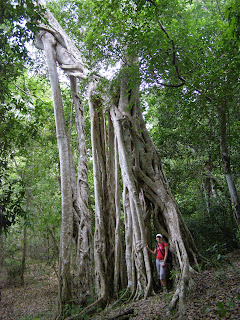I really only spent the weekend with them, however, before heading back to Xela for a few days: the faculty was still on holidays, and Dr. Figueroa appreciated having me around to help out!
This past week was MY week of “holidays”: I thought it would be a bit of a shame to spend 10 weeks in Guatemala without seeing the Mayan pyramids or the jungle. So…. I thought the 6-day, 125km trek to El Mirador (the largest known Mayan pyramid) through the jungle of the Petén region would be appropriate!

I booked the trip with a tourist group, and was accompanied by 6 other visitors, 2 guides, a cook, and a dozen mules to carry our equipment, food, water, and occasionally us. I became the translator of the group, as none of the 6 spoke Spanish, and the guide didn’t speak English! We visited 3 different groups of pyramids: El Mirador and Tintal (dating from around 300BC) and Nakbe (c. 700BC). Archaeologists are currently working on uncovering parts of the numerous pyramids that make up these sites, although the vast majority remains covered by forest. It was impressive to walk through vast stretches of jungle before practically stumbling across such large structures. We were able to crawl inside some of the tunnels dug into the pyramids to excavate, coming into contact with cave spiders, tarantulas, and carvings with some of the original red pain still preserved on them! It felt very “Indiana Jones”. We were also extremely lucky in terms of wildlife sightings. We saw countless groups of spider monkeys, saw (and heard) howler monkeys, and spotted a variety of birds (including toucans), snakes (including a 2-meter long boa and a night-time encounter with a poisonous snake- la “barba amarilla”), and lizards. We even saw some jaguar tracks! The bugs weren’t nearly as bad as Canadian mosquitoes, although we did have to remove the occasional tick. It was very hot and humid (probably about 35 degrees), but luckily it didn’t rain until the 4th day.

After 5 days of hiking and sleeping in a tent with a mattress that did little to soothe aching joints, I was ready for a bit of relaxation. A day in Flores (a tourist hot spot, built on an island in Petén) was just what the doctor ordered. I spent the day canoeing and swimming with another French vet student (Edouard, a friend of my ex-room mate, who happened to be doing an internship in Flores at the time!)
This week I will be at the Faculty of Veterinary Medicine, my last full week in Guatemala!
***
Bon, pour reprendre à partir de la dernière fois, j’ai passé une semaine et demie à la Clinique de Dr. Figueroa avant de retourner à Guatemala City avec Dr. Dugas (qui est venu à Xela pour une journée pour discuter du livre d’éducation avec Dr. Figueroa et des membres du Ministère de Santé Publique). C’était une visite très rapide avec lui, car il est parti en vacances deux jours plus tard. Depuis le 20 juin, je reste chez Dre. Blanca de Romillo, une prof à la Faculté de médicine vétérinaire qui spécialise en microbiologie. Elle et sa famille m’ont très bien accueilli, et je suis très confortable dans leur maison.
Je n’ai passé que quelques jours avec eux avant de retourner à Xela, car la faculté était toujours en vacances d’été, et Dr. Figueroa appréciait mon aide!
Cette dernière semaine, j’ai pris quelques vacances moi-même. Je pensais que ça serait un peu dommage de passer 10 semaines au Guatemala sans voir la jungle et les pyramides! Alors quoi de mieux qu’un trek de 6 jours, 125km dans la jungle de Petén pour voir El Mirador (le pyramide Maya le plus grand connu)?!

J’ai enregistré pour le trek avec un groupe de tourisme, et j’étais accompagné par 6 autres visiteurs, 2 guides, une cuisinière et une douzaine de mules pour transporter notre bagage, la nourriture, l’eau, et parfois nous-autres! Je suis devenue la traductrice, car les autres ne parlaient pas l’espagnol, et le guide ne parlait pas d’anglais non plus. On a visité 3 groupes de pyramides: El Mirador et Tintal (qui datent de 300 AC) et Nakbé (aux alentours de 700 AC). Des archéologues sont en train de découvrir certains segments des pyramides, mais la grande majorité reste recouverte de forêt. Il était très impressionnant marcher si loin dans la jungle avant de rencontrer de si grands structures sans préavis! On pouvait entrer dans les pyramides par des tunnels creusés par les archéologues, venant en contact avec des araignées, des tarentules, ainsi que des sculptures avec leur peinture rouge originale. Je me sentais très « Indiana Jones »! On avait beaucoup de chance en termes de rencontres avec la faune. On a vu plusieurs groupes de singes araignées, des singes « howler », plusieurs variétés d’oiseaux (dont des toucans), des serpents (y compris un boa de 2 mètres et un serpent venimeux), et des lézards. On a même vu des traces de jaguar! Les insectes étaient vraiment moins pires que nos moustiques canadiens, mais on a du enlever quelques tiques. Il faisait très chaud et humide (aux alentours de 35 degrés), mais heureusement il n’a pas plu jusqu’au 4e jour.

Après 5 jours de marche et de sommeil en tente, mes articulations étaient prêtes pour un peu de repos. Une journée à Flores était au menu (une ville touristique sur une île au Petén). J’ai passé la journée en canoë et en nageant dans le lac avec un autre étudiant de med vet (Edouard, un ami de mon ancien coloc, qui fait une stage à Petén en ce moment : que le monde est petit!)
Cette semaine je serai à la Faculté de médecine vétérinaire de l’université de San Carlos. Le prochain blog sera le dernier!

No comments:
Post a Comment